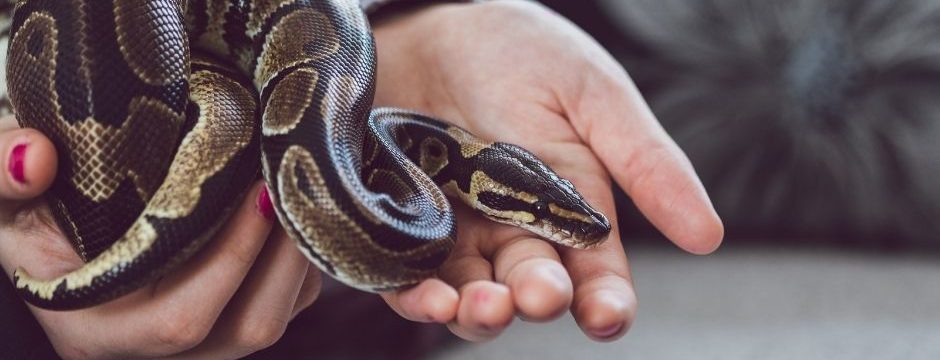Incredibly different from humans, reptiles are fascinating creatures. The fact they are so unlike us is one of the things that makes them extremely interesting, but this can also mean that caring for pet reptiles can be pretty tricky – as it’s often difficult to understand their behaviours. For instance, did you know that when you stroke a lizard on its head, if they start to close their eyes, this is normally a stress response, rather than a sign they’re enjoying the fuss! Read on to find out more about the best reptiles for beginners
Because of this, it’s really important to do your research before you consider getting a pet reptile – especially if you’re a beginner – as this will allow you to provide the very best quality of care for your new pet.
Reptiles for beginners
So, which reptiles make the best pets?
Unlike cats and dogs, reptiles are unlikely to form a close bond with humans. That being said, they may still form relationships with their owners, especially when it comes to feeding time. However, with many reptiles, it’s best to avoid handling them too regularly, as this can result in stress or aggression, and it can also be a potential health risk for owners if proper hygiene precautions are not taken.
When deciding which reptiles to keep as pets, there are four key points to consider:
- Environment: Exotic species will have specific space requirements, and their enclosures will need reptile-safe heaters, as well as appropriate humidity and UV lighting. Your reptilian pet will also need suitable enclosure décor to encourage natural behaviours, which may include basking, burrowing, hiding or climbing. Failing to meet any of these basic enclosure requirements can result in severe illness and even death for these animals – so it’s vital to research your reptile’s needs very carefully.
- Lifespan: Reptiles are infamous for living for long periods, with some species of snake living over 20 years, and certain types of tortoises reaching over 50 years in age! Because of this, it’s worth being aware of a reptile’s lifespan, so you can really think about whether you will be able to provide adequate care for this animal’s entire lifetime.
- Diet: Most reptiles will have very particular dietary requirements. It’s important you know exactly what nutrition your pet will need to stay fit and healthy, the potential costs of food and if you will be able to readily access these food types – particularly live food varieties.
- Enclosure mates: Most reptiles like to live alone, as they will see other animals – even those that are from the same species – as competition for resources. If you are considering housing reptiles together, again, make sure you do your research on how to do this appropriately, as some reptiles simply won’t tolerate living with other individuals. And even those reptiles that can live together will still need an appropriate enclosure size, adequate resources, a proper introduction and the option to have their own space if necessary.
It’s worth finding out if you have an exotic specialist vet in your area, as veterinarians with a particular interest in reptiles who have received additional veterinary exotic training will often be better equipped to look after your pet.
Reptile types
There are quite a few reptiles to choose from, and the choice can be a little overwhelming. To make things easier, we’ve put together a list of some of the best reptiles for beginners:
Bearded dragons:
Environment and lifespan: This species can live up to 15 years old, and can grow to 45cm long, meaning they need a vivarium that is 120cm x 60cm x 60cm as a minimum for one adult dragon.
Diet: In terms of diet, dragons will eat both insect and plant foods, appropriate supplements (and you can ask your exotic vet for further advice on this) and constant access to water. Baby dragons should be fed twice daily, while juveniles and adults should only be fed once a day.
Enclosure mates: Bearded dragons prefer to live alone, as males live a solitary life in the wild, and females will form a “pecking order” and may fight if housed together in captivity.
Handling: These lizards are generally active during daylight hours and tend to be relatively easy to handle, normally tolerating short handling sessions. Dragons are generally quite placid, although they can be a bit jumpier when they are less than a year old. If stressed, these animals may bite.
Shedding and brumation: Bearded dragons will shed their skin in large pieces, and there is no set rule about how frequently this should happen. During colder seasons, bearded dragons will slow down, eating less and sleeping more – a process called brumation. However, during this time they should not lose weight or stop eating, and you should get in touch with your vet if you notice this happening.
Leopard geckos:
Environment and lifespan: Leopard geckos can survive from 10-20 years in captivity if cared for appropriately. They can grow up to 20cm long – meaning one adult gecko will need a vivarium that is at least 60cm x 40cm x 30cm.
Diet: Geckos should consume a diet of live insects and fresh vegetables, with constant access to clean water and appropriate supplements (again, ask your vet for further advice). You should feed juvenile geckos every day, and adult geckos every other day.
Enclosure mates: These lizards are solitary and can be aggressive towards others, so we would recommend housing them on their own.
Handling: Geckos will tolerate short handling sessions. If stressed, these animals may bite.
Shedding and brumation: Leopard geckos will experience skin shedding, as well as brumation during the colder months. Again, they should never stop eating completely or lose weight, so contact your vet if you notice this.
Corn snakes:

Environment and lifespan: These snakes can live up to 10-15 years if cared for properly, and they can reach up to 150cm in length. Their enclosure should be at least as long as they are, with the vivarium height being over one-third of their total length.
Diet: Corn snakes should have a diet of dead adult mice every 1-2 weeks, with baby snakes consuming smaller mice (known as “pinkies”) every 5-6 days.
Enclosure mates: These snakes should be kept on their own, as they lead a solitary life in the wild, and their life in captivity should replicate this as much as possible.
Handling: Corn snakes can become used to handling, but they should only ever be handled for 10–15-minute periods, and it’s important to always make slow movements and never grab your snake – as they may bite if they’re feeling scared. If your snake does become stressed, they will sometimes show this by pulling their head back into an “S” shape, so if you see your snake doing this, you should stop handling straight away. Also, if you touch your snake’s prey before handling, always wash your hands thoroughly in between, as your snake could easily confuse you with their dinner!
So, that concludes our guide to the best reptiles for beginners. Always remember, if you have any questions or concerns about your reptile, it’s best to get in touch with an exotic veterinary specialist, who will be able to provide you with reliable information and advice.
Want more reptile advice? Check out our article on heat lamps.


